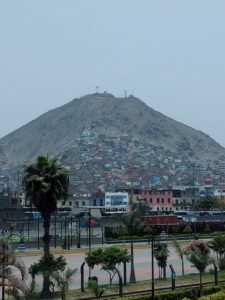 For someone with my background, the vulnerability is palpable, from densely clustered, unstable housing and chaotic traffic to a lack of paid first-responders.
For someone with my background, the vulnerability is palpable, from densely clustered, unstable housing and chaotic traffic to a lack of paid first-responders. 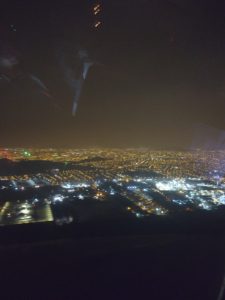
Peru’s National Civil Defense Institute forecasts up to 50,000 dead, 686,000 injured and 200,000 homes destroyed if Lima is hit by a magnitude-8.0 quake. Personally I think these numbers are conservative if Lima is hit by another event such as the 1746 earthquake/tsunami that destroyed most of the city.
Take a look at the video. This shows the Callao District close to where I am staying, where over 800,000 people reside. Should another 1746 earthquake occur, everyone needs to move 3.5 kilometers inland or get above 20 meters. Look at how many or how few buildings are six stories or more. Plus the taller buildings have to survive a massive earthquake! Traffic here is unlike anything I have experienced so all evacuation must be on foot or bicycle.
In one account of the 1746 Lima earthquake/tsunami, 5,000 people were living in the Callao District. They knew a massive earthquake had occurred, but no one knew a wall of water was only 20 minutes away. Only two-hundred people survived. Schools in the Callao District today practice to evacuate students to safe ground within 15 minutes, a very difficult feat.
Despite these daunting problems, I think Peru is doing better than we are in North America is some areas. There are a number of reasons we’re playing catch-up to Peru. One of the biggest reasons is that the Federal Emergency Management Agency (FEMA) wasn’t born until 1979. We’ve been at this game for less than 50 years. We must realize when it comes to the topic of preparedness we should learn from those who have experience we don’t.
It’s also possible FEMA’s mission is too broad. The mission of the FEMA is to reduce the loss of life and property and protect our institutions from all hazards by leading and supporting the nation in a comprehensive, risk-based emergency management program of mitigation, preparedness, response, and recovery.to support our citizens and first responders to ensure that as a nation we work together to build, sustain and improve our capability to prepare for, protect against, respond to, recover from and mitigate all hazards. It’s a great sound bite, but is it achievable? Maybe nationally we need to focus on the major events that will have the greatest consequences for communities and individuals and stop our frantic implementation of new programs based upon current events in the news or trending tweets.
Take the topic of earthquakes…big earthquakes…8.0M or better. Peru has about 200-400 minor earthquakes a year and a major one every six years. Over the last 450 years, they have had 15 monsters coming in at 8.0M or greater, once every 30 years on average! In North America over the last 318 years we have experienced just 5, with none of those occurring since the birth of FEMA. Because it hasn’t happened on our watch, I think we downplay the risk.
I have no doubt, the day after we experience an 8.0M or greater earthquake, we will be all excited about earthquakes. Unfortunately the damage will be done. Thoughts and prayers will boil out of officials mouths and blue-ribbon committees will be formed to determine what should happen for next time. We can and should do better, if FEMA’s mission is to be believed.
Leaders and planners at the Instituto Nacional de Defensa Civil or INDECI (the National Institute for Civil Defense) combine two distinct strategic areas: the technical and the social. They meld typical topics in Emergency Management such as planning, operations, logistics and resource management alongside realistic human behavior and response possibilities. Strategies are selected that are simple, practical and effective in developing the community’s role into one of shared, participatory responsibility. The public education campaigns are well thought out.
Because expectations are clear and simple, widespread community engagement is achievable. For example, they may not be able to address the housing construction practices quickly, but they can design programs based upon what those at-risk people can reasonably do in order to protect themselves. As a non-Spanish speaking person from a different culture, I have been able to pick up on what I should do if a major earthquake occurs. Critical signage in Lima is either simple to understand or also subtitled in English. Are we doing that in the states? 
Peruvian disaster preparedness planners have put their money where their mouth is and have an impressive exercise program. In Peru, they hold national-level earthquake/tsunami exercises four times a year, with schools exercising even more. Why? Because they know the consequences will be great when it happens. The last Cascadia national-level earthquake exercise in the United States was in 2016. Another is scheduled for 2022. Ouch.
Go to the gym every six years and tell me how that exercise program works out for maintaining your physical fitness. It should come as no surprise what our response looks like if we practice it once every six years.
I was privileged to be able to observe one of these national exercises a week ago. I was taken to the downtown center of Lima, in the Plaza de Armas for the national exercise at 8 pm. Several things impressed me right off the bat. The first is that my exercise location was one of 10 where activities were taking place. The public participates, and they did this exercise at night. When was our last national-level exercise starting at night? The INDECI planners in speaking with the public have learned they most fear something happening at night. So instead of exercising when convenient for 9-5 government-types, they held the exercise when it meant the most to those impacted.
The scenario used was based on a one-minute-long earthquake located at sea 190 km off the coast of Lima, measuring 8.0 on the Richter Scale, with an intensity of between VII and VIII on the Mercalli Scale. It happened at a depth of between 30 and 50 kilometers. This magnitude earthquake would create a tsunami that would reach low lying coastal areas within 15 to 20 minutes. 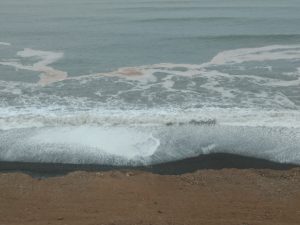 Many suburbs of Lima are located in these low-lying areas and are vulnerable to the threat of tsunami. These areas are populated with homes, schools, businesses, road, rail and air infrastructure etc. In this scenario, an estimated casualty toll of 50,000 people may be likely. Their exercises often include simulated activation of a request for international assistance. They know they will be over-whelmed so there is no delay to gain a common operating picture prior to asking for help.
Many suburbs of Lima are located in these low-lying areas and are vulnerable to the threat of tsunami. These areas are populated with homes, schools, businesses, road, rail and air infrastructure etc. In this scenario, an estimated casualty toll of 50,000 people may be likely. Their exercises often include simulated activation of a request for international assistance. They know they will be over-whelmed so there is no delay to gain a common operating picture prior to asking for help.
At the plaza INDECI staff were in attendance and temporary portable communications towers were set up outside to support the mobile command post tent. Police, volunteer firefighters, portable hospitals, healthcare workers, civil defense and civilian brigade members were present.
A key aspect of active participatory community engagement in Peru is the formation of brigadas; volunteer civil defense brigades. The objective is to have one brigade for every apartment block, office building, school, shopping mall or other shared space where groups of people live, work or congregate. The brigades are formed by eight crew members, aged between 19 and 40 years, one of whom is a trained first-aid provider. The crew members can attend basic training courses delivered by INDECI, but are not expected to develop high-level rescue or emergency response skills. In general, people are encouraged to help others, particularly vulnerable persons.
There is a place for Community Emergency Response Team (CERT) training as practiced in the states but I think Peru has been able to get better participation by scaling back performance expectations. The brigades are responsible to lead building evacuations, access caches of resources (first-aid supplies) and assemble their evacuees in the closest designated safe zone. By forming many of these small teams, people are encouraged to know each other, look out for each other and account for each other in emergencies. Greater social interaction for a common purpose.
At 8 pm the exercise began with sirens were from various sources: police car sirens in the streets, emergency sirens from local buildings and the cathedral bells. Groups of people were herded by the brigade members to move away from buildings into the street, form a circle and hold hands. There were numerous moulaged role-playing ‘injured’, carried to the Plaza on stretchers, and given medical care. The portable medical clinics are used daily around Lima so the staff are used to working within this environment. No struggling putting up tents they haven’t seen for three years. 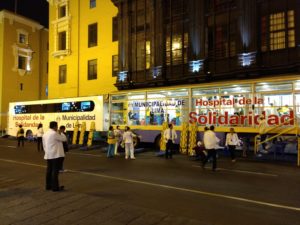
During an earthquake the first priority in Peru is to educate people to move to a strong area of the building then exit structures that may become unstable and move to safer, open areas. The safety plans of commercial buildings will show designated safe or reinforced structural elements within the building where people can take cover. These areas are clearly marked with signage.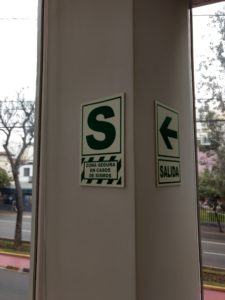
Then the procedure is to orderly evacuate buildings and re-group in nearby safe zones. These zones are marked by large yellow circles painted on flat open areas such as roads and car parks where local individuals and groups can assemble. In the event of a tsunami, escape routes in high-risk coastal areas are clearly marked on existing roadways and lead to safer areas on higher ground.
I expect to learn much more as I meet with subject matter experts in the military, fire service and civil defense organizations in the coming weeks. When I return to the states I look forward to helping progressive thinking communities and organizations adopt some of the strategies Peruvians are achieving success with.
Do you agree we have room to improve and can learn from developing nations?
Feel free to reach out to me on this topic at abetteremergency@gmail.com.


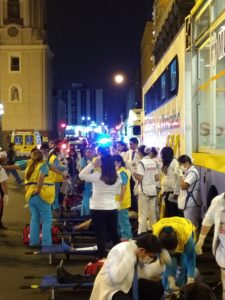


Leave A Comment